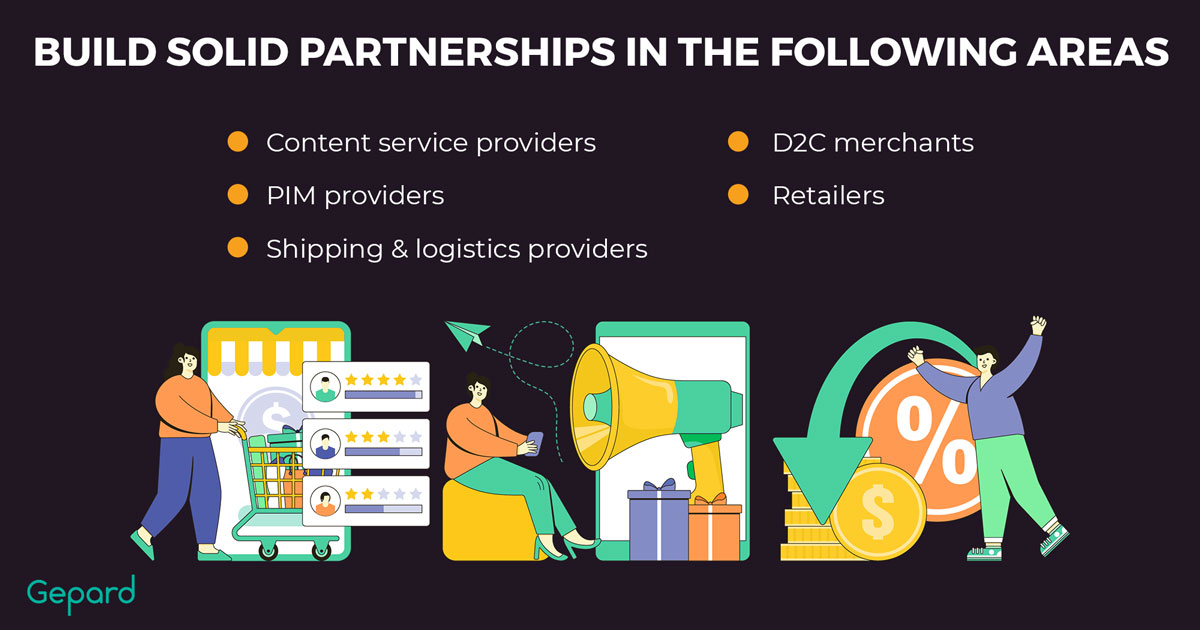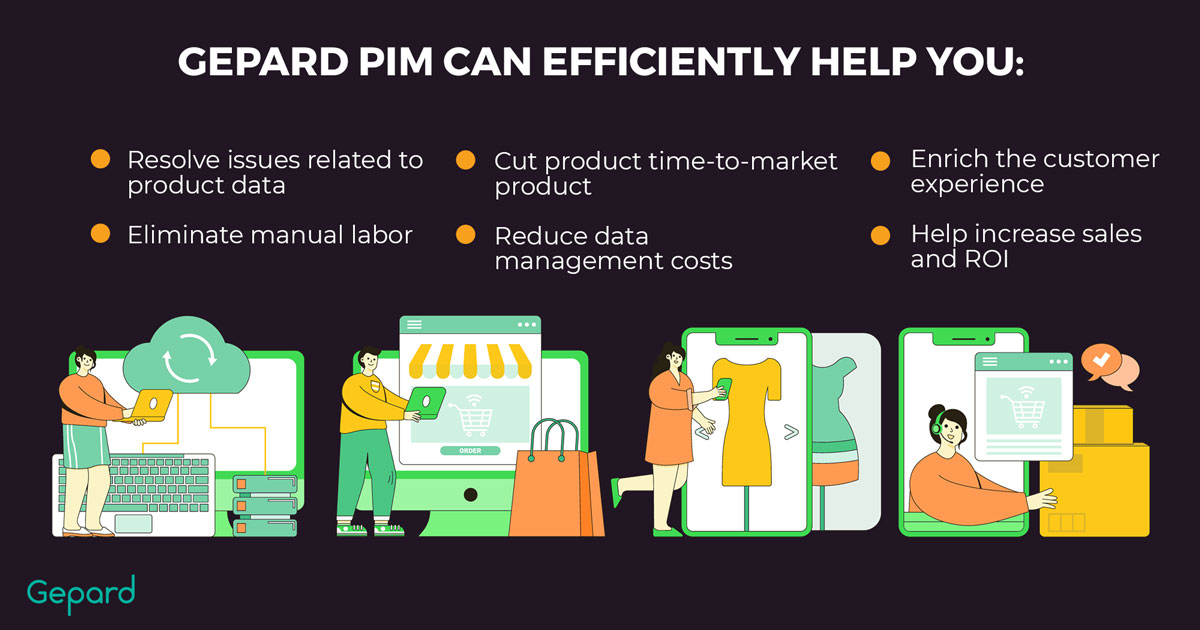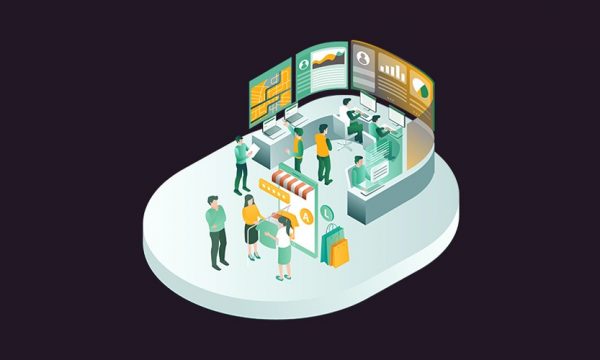How To Build A Successful eCommerce Ecosystem & Partnerships
To keep up a sharp competitive edge, companies consolidate the work of different teams or departments into sort of operational “alliances”. In close cooperation, they create products and provide services with boosted value. A dedicated eCommerce ecosystem helps centralize performance (for owners and employees) as well as create an understanding of the structure of the market and the variability of services provided (for consumers).
At Gepard, we know the ins and outs of laying down long-term efficient digital commerce ecosystems. And we are happy to share our own experience of creating the best eCommerce ecosystem with you.
What Is An eCommerce Ecosystem?
The vast and complex digital environment is made up of many subsystems that are combined to grant fast and smooth interaction between customers and merchants online. Let’s learn the typical components of the eCommerce ecosystem.
Platforms
You may analyze how the main types of platforms (PaaS, SaaS, and on-premises) will fit into the existing system architecture. Compare the cost, timing, and functionality of the system. PWAs (progressive web apps) can significantly reduce the loading time of your mobile site, which will give you an increase in conversion rates.
Marketing Tools
Search engines, advertising, and social media tools allow you to promote products and services across different markets. With the promotion mechanism, you can use dynamic pricing based on location. Recommendations help provide a personalized shopping experience by presenting customers with products that match their interests.
Payments
The availability of several payment methods gives the buyer the opportunity to choose the preferred one. Plus, online payments are secure and fast, while dynamic pricing and mobile wallet support help drive sales.
Logistics
Efficient logistics simplifies product turnover, as well as paperwork and tracking shipments around the world. The hyper-local delivery model and warehouse management system (WMS) are the foundation as they eliminate bottlenecks and thus help in business expansion.
Communication Tools
Consumer communication gives a huge advantage in terms of improving the product itself. It is important to properly organize the process of messaging, analyzing analytical data, and collecting feedback with the involvement of all customer service departments.
Productivity Tools
You also need tools to track, monitor, and measure the overall productivity of the team working on your eCommerce solution, thus registering the general performance and acquiring insights for optimizing and improving workflow.
For instance, solutions like Hubstaff, Google Workspace, and Coda offer digital spaces equipped with everything you need for streamlined collaborative workflow online (and offline where need be). For this, they provide dashboards, time trackers, budgeting and tasking tools, real-time reports, insightful analytics, communication spaces, and more.

Building An Efficient Business Ecosystem
Everyone who has ever shopped online has come into contact with systems that work together to improve the electronic delivery and sale of goods. In a regular consumer’s eyes, it is a single platform where you can choose and then pay for the goods in a convenient way. Each component of such a system works clearly, quickly, and smoothly. This is how the trust of customers is won, which is the main driver of the trading business growth.
Below, we outline major aspects that will help you choose the appropriate ways and means to ensure the proper functioning of such an ecosystem.
Make A Mindmap Of Your Flows And Connections
For your system to work flawlessly, you must put yourself in your client’s shoes. Start with an eCommerce ecosystem map showing the entire buyer journey. Map out all available options with the right destinations and events, and fill in the gaps to reduce the chance of losing income.
Ensure Each Component Works Without Fail
Simulate the customer experience from the first site visit to the actual sale and shipment of the product to identify which stages the buyer goes through smoothly and which may hinder their experience.
1. Check Website Performance
Your ecosystem may be sturdy enough in terms of functionality and UX, but you still may notice such shortcomings as:
- slow site loading;
- insufficient speed or accuracy of the payment process.
The first ten seconds of a user’s visit to a page are considered critical – this is your chance to ultimately grab their attention. If your site is not loading or updating product listings or product pages slowly, your potential customer may switch to competitors at once.
2. Ensure The Site Works At Every Step Of Your CJMs
The buyer should receive the desired product quickly and easily, as well as appreciate the ease of navigation. The search query should indicate exactly what the buyer is looking for. Use a list of “most popular” as well as reviews and ratings that can be indexed based on needs.
After payment, the consumer should quickly receive a receipt with an estimated delivery date. It is also good to warn the client about possible delays and offer them a small discount on the next order. It is important for consumers to feel safe at all times, so make sure that their personal data does not seep through into the public domain.
Read more about eCommerce website search trends:
3. Check APIs And Other Connected Services Stability
The platform serves several processes at the same time, so it can sometimes seem slow. You must make every process easier and safer to use. APIs allow you to efficiently manage inventory, orders, and payments by providing an accessible and secure connection between different applications. With their help, you will be able to collect accurate data, which can help improve the quality of service and customer retention.
Build Solid Partnerships
By expanding co-marketing and your customer base, you will earn more. Partnership and consolidation towards a common goal is the backbone of the ecosystem, so choose the right partners, particularly, in the following areas.
1. Content Service Providers
There are several types of content providers:
- CSP is a cloud directory service provider;
- CaaS is Content as a Service delivered on demand through web services.
To determine the best one for you, you must get your priorities straight (omnichannel delivery, high scalability, personalization, and security). To get the most out of cooperation, we recommend focusing on the coverage of the product portfolio. Icecat, covering more than 24 000 brands catalog is among the most popular.
2. PIM Providers
Centralized product data management includes the management of content and other materials needed for marketing and sales. PIM also guarantees high-quality information for internal use and multichannel marketing.
Choose a solution with the following features:
- custom integration with external systems;
- a unified system for displaying goods;
- content filling;
- manual creation of new products;
- role and access management;
- management of statistical pages.
3. Shipping & Logistics Providers
Commonly, large online stores use third-party services for goods delivery. Outsourcing provides efficient shipment management. Companies like FedEx, Ekart, and the like making things a lot easier, but you have to integrate their existing systems with yours.
4. D2C Merchants
D2C is a sales model where companies produce, promote, sell, and deliver products without intermediaries, and it has proven to be an advantage for many. It can help you cut costs and streamline sales by granting buyers a more convenient and profitable way to make purchases.
That way, you can provide customers with a full-service cycle, including:
- personalized ordering;
- convenient payment methods;
- up-to-date information about the availability of positions in the nearest warehouse;
- built-in online chats (messengers), video chats, and other means of communication on one site;
- product matching, which allows you to monitor the manufacturer’s product matrix and compare it with prices on other sites;
- smart search, automatic collection of analytics, and other necessary options.
5. Retailers
Using knowledge of consumer behavior, retailers, and advertisers can compose messages and experiences that reflect the values of the target audience at all stages of the sales funnel. The growth of eCommerce for them can expand the reach of their brands and have a positive impact on profits since they receive all the sales proceeds, not a percentage.
Walmart, Target, The Home Depot, and Apple operate their own online stores where they sell directly to consumers without a middleman (as opposed to Amazon).

Business Ecosystem Examples
Sales
The field of sales is right there in the middle of a common business ecosystem, making up major tasks and efforts to push business.
- eCommerce
Some of the most popular platforms here are Squarespace, Wix, Commerce Cloud, BigCommerce, Magento, and Salesforce. For small and start-up businesses, Tictail, Squarespace, WooCommerce, and Shopify are suitable as they are easier to use and can be quickly set up to handle high order volumes.
- mCommerce
Mobile commerce options are often dismissed due to slow loading pages, difficult-to-enter forms, payment, and security (trust) issues. However, there are solutions that have proven otherwise:
- One-Tap Gifts from 1-800-Flowers is the leader in flower delivery with one-touch purchases, multiple order messaging options on the mobile app, and payments via Venmo and other digital wallets.
- Skip-the-Line by Dominos is a pizza chain that has launched Dom, an AI-enabled chatbot with Pie Pass technology to make it easier for customers to get takeaway pizzas out of line.
- 7-Eleven Cashier Less Pilot ─ mobile checkout allows you to purchase goods without waiting in line after paying online.
Finance
Below are the eCommerce applications related to this important area of the business resource application.
- Payment Processing
eCommerce applications open up new opportunities for small businesses as it becomes possible to accept bank card payments through mobile devices. To be able to use this technology, small businesses only need a card reader provided by the company. We recommend Zettle and Square solutions.
- Financial Accounts
Small businesses may efficiently manage their financial accounts using cloud-based applications such as Kashflow or Clear Books. Accounting software provides many options, including access to credentials on any platform connected to the Internet. It can be used to set up automated tasks such as recurring billing and late payment reminders.
Human Resources
Businesses must make decisions that benefit and help reduce costs. The role of personnel in this matter is invaluable. In a virtual environment, your employees can be replaced by external professionals.
- Project Management
For this task, as well as collaboration and task setting, we recommend a fairly balanced Basecamp service and Teambox cloud solution. With their help, you can create a successful business ecosystem example.
- Specialists
Small businesses often lack specialized skills and experience. As a result, bad decisions are made, problems appear, or opportunities are missed. To solve this problem, small businesses can use apps like Clarity, which allows users to place phone calls with specific industry experts.
Read more about building a successful eCommerce team:
Communication
Communication with customers and partners is crucial in terms of business management and development.
- Task Management
The Asana app organizes work so everyone knows what to do, why it is important, and how to do it. Gathering creative feedback, budget approval, and launching a branding campaign will be no problem for you.
- Collaboration Tools
For companies of various levels, Skype is still the most popular online corporate communication tool. You can also search for a suitable option among the vast range of Google Apps.
Information Technologies
In our opinion, among the notable players in an eCommerce ecosystem, the most promising are the following.
- Cloud Solutions
Amazon S3 is storage for any amount of data with constant real-time access. The system offers tools to help you organize and manage specific use cases, costs, security, and compliance.
- Support
Log Main is a set of solutions that help organize remote work, communication, collaboration, support, and the security of your staff and customers.
eCommerce Partnerships
For the constant growth of your eCommerce business, you will need reliable, proven partners. These are the following:
CSPs
Among the major cloud IaaS providers, you should pay attention to Amazon Web Services which provides on-demand cloud computing services, and Microsoft Azure with its analytics, computing, networking, and storage cloud-based services. Among PaaS providers is Salesforce which can be customized to meet your business needs, Oracle which is rated as the world’s biggest database management company, and, of course, Google. The top SaaS providers are Microsoft Office 365 which enables you to manage your entire cloud customer lifecycle, Box with its intelligent content security and automation capabilities, and Slack, a simple cloud-based platform for seamless communication within your organization.
Marketplaces
The Amazon-managed marketplace is the most common model for online sales. Another prominent example is eBay. Also popular are Google Shopping, Bol.com which is very widespread in the Dutch market, and Zalando which is favored in Europe.
PIM Solutions
Let’s take a look at some important statistics about the use of PIM software within eCommerce projects:
- Yes (44%);
- Yes, but needs to be enlarged/improved (21%);
- No, but considering (17%);
- No, but currently implementing (11%);
- No and not considering (4%);
- Don’t know (3%).
As you can see, for the B2B eCommerce ecosystem, a good PIM is extremely important. Look for products with full real-time access to all product data and easy integration with CRM, ERP, warehouse activities, etc.
Shipping & Logistics
The top relevant services here are UPS, which is very popular in the USA, FedEx with a broad portfolio of transportation and eCommerce services, DHL, which specializes in international shipping and transportation, or Flexport, which helps business grow their entire supply chain. You can also choose Echo Global Logistics with its multimodal shipping services or C.H. Robinson which is also operating across the globe.
How Partnering With Gepard Enhances B2B eCommerce Ecosystem
Gepard PIM easily connects you with marketplaces, retailers, and all required sales channels. This advanced solution serves as a single database that allows users to easily manage, enrich, and distribute product information across multiple sales channels.
Ultimately, Gepard PIM can efficiently help you:
- Resolve issues related to product data;
- Eliminate manual labor;
- Cut product time-to-market product;
- Reduce data management costs;
- Enrich the customer experience;
- Help increase sales and ROI.
We offer a platform with a well-designed ecosystem, including several integrated applications and systems focused on eCommerce. Gepard PIM solution provides a multichannel and fully automated experience designed to help you boost online sales.

B2B eCommerce Ecosystem FAQ
What Is An Ecommerce Platform Ecosystem?
An eCommerce platform ecosystem is a complex stack of interconnected systems that streamline business operations online. The number of underlying components in such ecosystems may vary depending on the size of the business and the scale of the platform used.
What Are The Benefits Of Partnering With Global Technology Companies?
The growth of trust that online tools guarantee, including rating systems, user reviews, and purchase protection, all increase business success.
1. Transparency of operations. Global platforms widen the consumer audience and flexibility in presenting products at the international level.
2. Increase productivity by reducing overall costs when moving to digital tools.
3. Expanding the business and market knowledge base with easy access to large volumes of educational resources.
Bottom Line
Most eCommerce ecosystems need to be reviewed from time to time. By choosing Gepard PIM, you address your core business data management needs for long-term efficient, advanced data management capabilities.
If you don’t know how to build a business ecosystem, contact us for detailed clarifications. And feel free to request a customized Gepard PIM demo to see the rates of performance you may achieve today with your own eyes.






